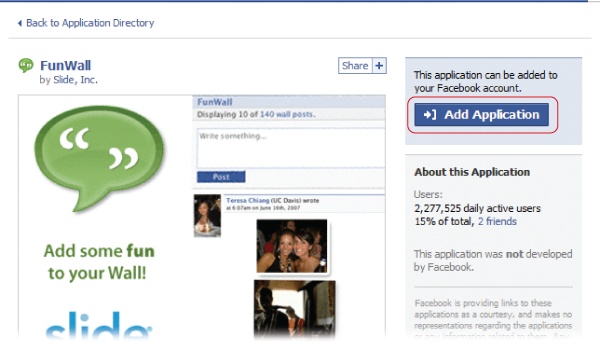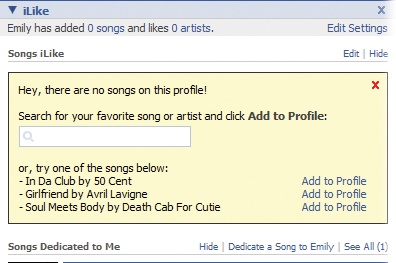Chapter 12. Customizing Facebook and Adding Applications
Facebook is a pretty polished-looking site, and it wants to stay that way. Unlike MySpace—where you can customize just about everything on your personal page—you can’t go hog-wild changing the way Facebook looks. You can adjust only the layout of your home page and profile ever so slightly. But you can do something much cooler than, say, changing the background color of your profile page: Facebook lets you add applications—tiny programs that run inside Facebook.
Second only to the friend-to-friend interactions Facebook tracks for you, applications are one of the main reasons for Facebook’s explosive popularity. Why? They’re fun! And they can be useful, too. Applications lgt you do everything from silly stuff (such as “spray painting” on your friends’ walls or sending your friends virtual potted plants that grow a little each day) to useful things (such as adding chat capability to your Facebook profile or creating a terrific-looking resumé from right inside Facebook).
Note
Facebook granted programmers free access to the Facebook platform in May of 2007, meaning that for the first time ever, anybody with the programming chops and the desire could create an application. Since then, the number of Facebook applications has skyrocketed. If you can imagine it, somebody’s probably created a Facebook application that lets you do it.
As this book goes to press, you can choose from over 10,000 Facebook applications. Read on to learn how to find and install the best of the bunch.
Modifying Your Home Page and Profile
Facebook gives you a few modest ways to customize the layout of your home page and profile. You can:
Collapse and expand sections of your profile. Click a blue section heading to collapse that section; click it again to expand the section.
Tip
If a down arrow precedes a section heading, that section is already expanded, so clicking the heading will collapse it. A right arrow means the section is collapsed, so clicking the heading expands it.
De-emphasize news items and hide sections of your home page. To de-emphasize a news feed story that’s on your home page, head to the right side of the story and click the X. When you do this, the story’s text gets really faint and the story gets reduced to one or two lines. The story doesn’t disappear completely, but it isn’t quite as in-your-face annoying.
Note
Facebook remembers which stories you de-emphasize and fine-tunes your news feed accordingly. If you really enjoy a certain story, click the thumbs-up icon next to the X to tell Facebook to display more of that kind of news.
To remove a section on your home page, click the “hide” link on the right side of the section heading. When you do, Facebook replaces the “hide” link with a “show” link you can click to restore that section.
Hide the applications on your profile. Applications show up on your profile page below your mini-feed (Mini-feeds: What You’re Doing) and personal info, as well as below your profile picture. Clicking the X in an application’s blue header displays a pop-up box that lets you choose between hiding the application (you can get it back by editing your applications settings as shown in Controlling Where Applications Appear and Who Knows You’re Using Them) or removing it altogether.
Note
Applications only show up on your profile page if you say so. You can tell Facebook to display an application on your profile when you first install the application (Adding Applications), or later by editing the application’s settings (Controlling Where Applications Appear and Who Knows You’re Using Them).
Reposition sections of your profile. To do so, mouse over the heading of the section you want to reposition. (Your cursor turns into a four-headed arrow when you’re in the right spot.) Then just click and drag to move the section.
Note
You can’t reposition your mini-feed (Mini-feeds: What You’re Doing)—it’s always at the top of your profile—but you can collapse it.
Facebook Applications: An Overview
Facebook applications are small programs that work inside Facebook. They’re similar to Web browser plug-ins (like video players) in that they let you do a little something extra—something you couldn’t do before you installed them. They’re easy to install and appear on your Facebook Applications menu.
If you’ve had a chance to put Facebook through its paces, you’re probably already familiar with the site’s built-in applications, which include Groups, Events, Photos, and Marketplace. But people who aren’t on the Facebook design team—folks known as “third-party developers”—have written about a bazillion others, such as iLike (which lets you add music clips to your profile) and Weekly Schedule (which lets you coordinate a graphic version of your schedule with your co-workers’ or friends').
Nearly all the initial third-party Facebook applications are humorous time-wasters, like the ones that let you spray-paint graffiti on someone’s wall or hurl virtual sheep at your friends in lieu of a sedate poke (Poking). But you can expect to see more serious-minded, business-friendly applications now that Facebook’s enormous (and growing) membership is attracting high-dollar advertisers. Professional Profile, for example, lets you post and edit your resumé on Facebook, then track who views it. Chat-Instant Messaging lets you add an instant-messaging box to your profile so you can communicate with co-workers without ever leaving Facebook.
Facebook applications are super easy to find, install, and use. The only downside to using them is that you automatically grant the application’s developers access to your profile, which poses a security risk. Flip to Applications and Privacy to learn more.
Note
If you’re interested in creating a Facebook application of your own, check out http://developers.facebook.com for details on the newly released Facebook development platform. (You can get to that site by scrolling to the bottom of any Facebook screen and clicking the Developers link.) And for a business-minded analysis of the application market, check out The Facebook Application Platform: An O’Reilly Radar Report (http://radar.oreilly.com/research/reports/facebook.html).
Finding Applications
Facebook’s application directory lets you search for applications by category or popularity, or see a list of the newest ones. To find applications:
Head to the Applications menu and click either the Applications link or the “edit” link next to it. Then, on the Edit My Applications page that appears, click the Browse More Applications button.
Browse the applications. If you know what you’re looking for—something that might make college life easier or more fun, for example—head to the right-hand column and choose a category such as Education. If you’re curious which applications people are using or which ones are hot off the press, click one of the tabs at the top of the page: Recently Popular, Most Activity, Most Active Users, or Newest.
Tip
If you know the name of the application you’re looking for, type it in the Search Apps field and hit Return.
Adding Applications
You have to install Facebook applications before you can use them, but installing them is a snap:
In the Application Directory, click the name of the application you want to install. Up pops a page with more info about the application.
Tip
Here’s another way to add applications: When you’re browsing a friend’s profile and see an interesting application, click the “add” link on the application’s blue header. Then jump to step 3 below.
Click the Add Application button.
On the confirmation page that appears, decide how much of your personal info you want to share with the application. You can turn off all the checkboxes except “Know who I am and access my information” (turn that one off, and Facebook won’t let you install the application).
Tip
Leave one or both of the “Place a link” checkboxes turned on so you can find the application easily after you install it.
Note
You can add some applications to your Facebook Pages (Facebook Pages: Profiles for Bands, Brands, and More)—if you have any—in addition to adding them to your profile. On the confirmation page, you’ll see separate “Add to Profile” and “Add to Page” buttons.
Click the Add button. Facebook installs the application and displays it so you can start using it right away.
Using Applications
The way you use an application and the things you can do with it completely depend on the application itself. But the way you open an application so you can use it is always the same: Head to the Applications menu and click the name of the application you want to use. (Alternatively, you can head to your profile and click either the application’s icon that appears under your profile picture, or the blue link that appears in the section of your profile dedicated to that application (the wording of the link depends on the application).
Wherever you find the application link, as soon as you click it, Facebook displays the application, all ready to go.
Tip
If you chose not to display the application on your profile or in your Applications menu (see Controlling Where Applications Appear and Who Knows You’re Using Them), you can still use the application. To do so, scroll to the Applications menu and click the “edit” link. Then, on the Edit My Applications page, click the name of the application you want to use.
Troubleshooting Applications
If an application doesn’t behave the way you expect it to, you’ve got a couple of options: You can delete the application (see Deleting Applications) or check to see if there’s a help or Frequently Asked Questions page. If there’s not a help page, or if the FAQ doesn’t answer your question, you can contact the folks who created the application. Here’s how to check for a help page and contact an application’s creator:
Scroll to the bottom of any Facebook screen and click the bottom-right Help link.
Scroll to the bottom of the Help Topics screen. In the Added Applications section, click the name of the application you need help with.
In the Help box that appears, click the “help page” link (if one exists). If there isn’t a help page for the application or if you read the help page and it doesn’t help, type your question or feedback in the Your Message text box and click Send.
Controlling Where Applications Appear and Who Knows You’re Using Them
When you first add an application, Facebook gives you the opportunity to tell it where you want the application to appear: on your Applications menu, for example, or on your profile as either a section, or as a tiny icon beneath your profile picture. (See Deleting Applications.)
But you can change your mind at any time and, for example, tell Facebook to stop displaying an application on your profile. In addition, you can tell Facebook whether or not you want the site to announce what you do with the application on your mini-feed and in your friends’ news feeds.
To change where an application appears and who gets to know you’re using it:
Head to the Applications menu and click the “edit” link.
On the Edit My Applications page that appears, find the name of the application you want and click Edit Settings.
In the Edit Settings box that appears, tell Facebook where to display your application, and who to tell about it. Most of the options are pretty clearly described for you, but two are a little confusing. Choosing any selection other than “No one” from the Profile drop-down list adds a section to your profile similar to the one you see on the next page. Checking the Profile Links checkbox adds a tiny icon to the row of icons that appears right below your Profile picture.
Tip
Not all applications offer additional settings, but some do. If you see the Other Privacy Settings link, click it. Doing so lets you control what kinds of additional things—such as links and even other applications—the application can display on your profile.
Deleting Applications
If you decide you don’t like an application or just find it takes up too much real estate on your Applications menu or profile, you can delete it quickly and easily:
Head to the Applications menu and click the “edit” link.
On the Edit My Applications page that appears, find the name of the application you want to delete and click the Remove link. In the confirmation box that appears, click Remove.
If you change your mind and want to use the application again, simply reinstall it (Adding Applications).
Tip
To hide your application without deleting it, edit your application settings. Controlling Where Applications Appear and Who Knows You’re Using Them shows you how.
Customizing Your Applications Menu
Unless you tell it otherwise (Controlling Where Applications Appear and Who Knows You’re Using Them), Facebook lists all your applications (in the order you installed them) on the Applications menu, with the built-in Facebook applications at the top of the list. But you can reorder the list. You might want to do this if you find yourself using one application more than the others and want it at the top of your Applications menu. To reorder your Applications menu:
Head to the Applications menu and click either Applications or the “edit” link. Facebook puts a four-headed arrow in front of each of your application listings.
Click and drag the four-headed arrow next to the listing you want to move. When you’ve put the listing where you want it, let go of your mouse.
Note
Instead of clicking and dragging the arrow, you can click and drag the application link itself.
Get rid of the arrows. When you finish rearranging your Applications menu, click anywhere else on the screen (for example, the Facebook logo ) to redisplay the menu with clickable links—and no arrows.
Applications and Privacy
Before you can install an application, you have to agree to give that application’s creators access to all—yes, all—the personal info you’ve typed into Facebook (that’s what the “Know who I am and access my information” checkbox means—see step 3 in Adding Applications). What’s more, Facebook isn’t responsible if these folks use your personal information for nefarious purposes, lose it, sell it, or write it across the sky in 200-foot-high letters. That’s a scary thought—especially if you’ve added your home address, credit card info, or other super-sensitive details to your Facebook account.
Chapter 13 discusses privacy in detail, and you really, really ought to read it. But the upshot is this: When deciding whether you want to share your info, think about how much sensitive stuff you’ve typed into Facebook, how bad off you’d be if it fell into the wrong hands, and how useful you find the application you want to install.















